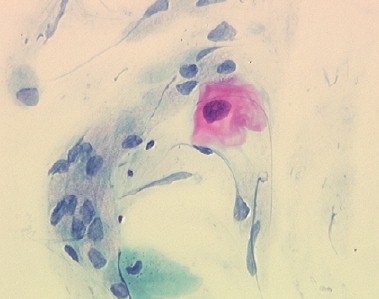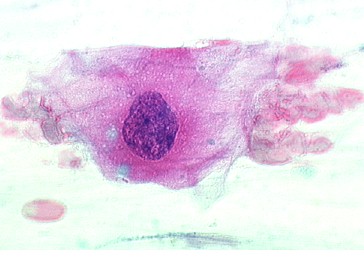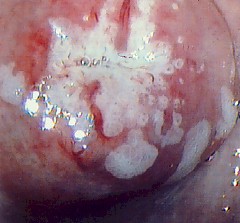
Atypical squamous cell (ASC-US)

Atypical squamous cell (ASC-US)

Colposcopy from above patient

Cervical biopsy from above patient, showing low grade SIL |
A report of ASC (Atypical Squamous Cells) is the way
the cytologist tells you that there is something on the patient's Pap smear that is not
perfectly normal, but they can't tell with any certainty what it is or whether
or not it is
significant. ASC Paps are subdivided into two types:
- ASC-US (undetermined significance)
- ASC-H (cannot exclude high-grade SIL)
Among the women with ASC are a few with high-grade lesions of the
cervix:
- Between 5% and 17% of women with ASC-US will have a high grade SIL
present (CIN 2 or CIN 3)
- Between 24% and 94% of women with ASC-H will have a high grade SIL
- The risk of invasive cancer of the cervix is about 0.1% to 0.2%
among women with any ASC Pap.
Several approaches to management of the patient with ASC are
acceptable, among them are:
- Immediate colposcopic evaluation
- Repeat Pap smear in 4-6 months with colposcopic evaluation of
those with persistently abnormal findings. For those without
persistence of the abnormality, close followup is usually
recommended because of the known error rates of screening Pap
smears.
- Reflex testing of the Pap smear for the presence of high-risk
HPV subtypes. Patients with high risk HPV undergo colposcopy.
Patients without high risk HPV are followed closely.
- If the patient has previously been evaluated for an abnormal Pap and
found to have either mild dysplasia or HPV
changes, the occurrence of an occasional ASC-US smear is not surprising and is often
considered normal for that person. In higher risk circumstances, further colposcopy is
sometimes undertaken to re-evaluate the cervix.
- A patient with a history of cervical dysplasia, who has had
many normal Pap smears following treatment, and who develops ASC-US should probably be
re-evaluated colposcopically if she has not had that procedure done recently, as this
could represent the beginning of a new problem.
Military Obstetrics & Gynecology
© 2003, 2004, 2005, 2006 Medical Education Division,
Brookside Associates, Ltd.
All rights reserved
|




